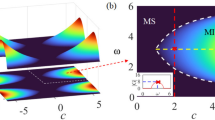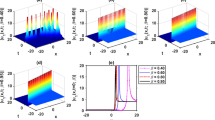Abstract
We investigated forced Lamb waves using the method of multiple scales and Green’s function method. With the former method, we derived a solvability condition containing terms describing forced effects. In Lamb waves problems, the solvability condition is a first-order partial differential equation in contrast to the governing equations describing Lamb waves, which are second-order partial differential equations and boundary conditions. With the latter method, we obtained the Green’s function for the solvability condition. This way of deriving the Green’s function is easier than solving the governing equations for Lamb waves. Finally, we obtained the amplitudes of the forced Lamb waves using the Green’s function. The proposed method may be used to obtain the amplitudes from arbitrary forced distributions in both the time and space domains. Furthermore, the method may be used to obtain the frequency and wave number responses that take into consideration the detuning effects and may be used to consider dispersion effects. As a result, we found out that some kind of resonance occurs when the relation between input position and time delay corresponds to the group velocity of the input propagation mode. Solutions obtained by our method were verified using the frequency-domain-based integral transform method.










Similar content being viewed by others
References
Mishra, S., Kumar, A., Mishra, R.K., Sharma, S., Singh, S.: Structural health monitoring and propagation of lamb waves to identification of crack. Mater. Today: Proc. 2(4), 1833–1840 (2015)
Rose, J.L.: Ultrasonic Guided Waves in Solid Media. Cambridge University Press, New York (2014)
Hayashi, T., Song, W.-J., Rose, J.L.: Guided wave dispersion curves for a bar with an arbitrary cross-section, a rod and rail example. Ultrasonics 41(3), 175–183 (2003)
Mazzotti, M., Marzani, A., Bartoli, I., Viola, E.: Guided waves dispersion analysis for prestressed viscoelastic waveguides by means of the safe method. Int. J. Solids Struct. 49(18), 2359–2372 (2012)
Treyssède, F.: Dispersion curve veering of longitudinal guided waves propagating inside prestressed seven-wire strands. J. Sound Vib. 367, 56–68 (2016)
Broderick, H.C., Dorfmann, L., Destrade, M.: Electro-elastic lamb waves in dielectric plates. Extreme Mech. Lett. 39, 100782 (2020)
Sharma, B.L.: On linear waveguides of square and triangular lattice strips: an application of Chebyshev polynomials. Sādhanā 42, 901–927 (2017)
Sharma, B.L.: On linear waveguides of zigzag honeycomb lattice. Waves Random Complex Med. 28(1), 96–138 (2018)
Eremeyev, V.A., Sharma, B.L.: Anti-plane surface waves in media with surface structure: discrete vs. continuum model. Int. J. Eng. Sci. 143, 33–38 (2019)
Carta, G., Nieves, M., Brun, M.: Lamb waves in discrete homogeneous and heterogeneous systems: dispersion properties, asymptotics and non-symmetric wave propagation. Eur. J. Mech. A/Solids 104695 (2022)
Kaplunov, J., Prikazchikov, D., Prikazchikova, L.: Dispersion of elastic waves in a strongly inhomogeneous three-layered plate. Int. J. Solids Struct. 113, 169–179 (2017)
Prikazchikova, L., Ece Aydın, Y., Erbaş, B., Kaplunov, J.: Asymptotic analysis of an anti-plane dynamic problem for a three-layered strongly inhomogeneous laminate. Math. Mech. Solids 25(1), 3–16 (2020)
Auld, B.A.: Acoustic Fields and Waves in Solids. Wiley, New York (1973)
Zhang, P., Qu, J.: Forced guided waves in linearly elastic plates (i)-an examination of the normal-mode expansion method. Ultrasonics 108, 106231 (2020)
Zhang, P., Qu, J.: Forced guided waves in linearly elastic plates (ii)—a modified normal-mode expansion method. Ultrasonics 108, 106232 (2020)
Kanda, K., Sugiura, T.: Internally resonant guided waves arising from quadratic classical nonlinearities with damping. Int. J. Solids Struct. 216, 250–257 (2021)
Kanda, K., Sugiura, T.: Analysis of damped guided waves using the method of multiple scales. Wave Motion 82, 86–95 (2018)
Kanda, K., Maruyama, T.: Theoretical analysis of the dispersion of lamb waves forming a wave packet of finite-bandwidth using the method of multiple scales. Int. J. Solids Struct. 111268 (2021)
Author information
Authors and Affiliations
Corresponding author
Additional information
Publisher's Note
Springer Nature remains neutral with regard to jurisdictional claims in published maps and institutional affiliations.
Appendices
Appendix A: Coefficients in the amplitude equations
The expressions for coefficients \(C_{j1}\) and \(C_{j2}\) are
Appendix B: Green’s function and integral representation
Green’s function for Eq. (11) \(G(x_1,t_1;y, \tau )\) is defined as
where \(\delta (\cdot )\) indicates the Dirac delta function. From a physical viewpoint, this Green’s function is interpreted as a propagating wave packet. Therefore, we impose a causality condition in which the wave packet propagates in the positive \(t_1\) direction.
The Fourier transform of Eq. (B3) with respect to \(x_1\) and \(t_1\) is
where \(\omega _1\) and \(k_1\) are the circular frequency and wave number, respectively. From Eq. (B4), \(\hat{G}( k_1, \omega _1;y, \tau )\) becomes
Using the inverse Fourier transform, \(G(x_1,t_1;y, \tau )\) is
where we have used the causality condition to evaluate the contour integral; here \(H(\cdot )\) denotes the Heaviside function.
Multiplying Eq. (11) for \((y, \tau )\) by Green’s function \(G(x_1,t_1;y, \tau )\) and then integrating over \(\mathbb {R}^2\) with respect to y and \(\tau \), we obtain
An integration by parts yields
where \(Y_0\) is the homogeneous solution of Eq. (11) and is given by
The second term on the right-hand side of Eq. (B8) is the particular solution of Eq. (11). In this study, we set \(Y_0=0\) because our focus is on the problem for forced Lamb waves.
Rights and permissions
Springer Nature or its licensor (e.g. a society or other partner) holds exclusive rights to this article under a publishing agreement with the author(s) or other rightsholder(s); author self-archiving of the accepted manuscript version of this article is solely governed by the terms of such publishing agreement and applicable law.
About this article
Cite this article
Kanda, K., Maruyama, T. Theoretical analysis of forced Lamb waves using the method of multiple scales and Green’s function method. Acta Mech 234, 3533–3546 (2023). https://doi.org/10.1007/s00707-023-03573-8
Received:
Revised:
Accepted:
Published:
Issue Date:
DOI: https://doi.org/10.1007/s00707-023-03573-8




